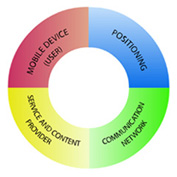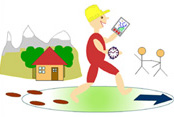1.5. Summary
Location Based Services will become more and more part of our everyday life.
First services are already provided for mobile phone users like friend finders,
weather
information or city event boards. Other location services like road tolling for
trucks
or fleet management are also already operational LBS business applications. In
this
lesson we defined first what Location Services are and presented afterwards some
fundamental characteristics of such services:
- We saw that the LBS architecture consists of
five basic components: Mobile Devices, Positioning,
Communication Network, Service Providers and Content Providers. These
components have been shortly discussed in the last subsection of the lesson.
Further we gave an example how these components act together in the
processing chain of a service request sent by a user.
- In the second section we presented user
actions and questions from which the types of services
(operations), needed by users, emerge. Five types of actions have been
identified: locating, searching, navigating, identifying and checking.
- Context awareness has been emphasised as
a major feature of LBS technology. Therefore context has been defined and 9
types have been listed and visualized (e.g. location, time, social
situation, system, etc.).
- Using context in an LBS application has been introduced as adaption. Four levels of adaption have been
identified (information, technology, user interface and presentation) and
effects could be discovered in an interactive tool.
- Finally a long list with LBS application examples has been given and four
properties to characterise an
application are presented: the application area (e.g. navigation, emergency,
information, etc.), positional accuracy needs, application environment
(indoor/outdoor), and delivery type (push and pull services).
|
  |
Since this lesson does present only the basics on LBS the further lesson will
give some closer insight into the characteristic, partially with a specific focus
on map
presentations of results received from a Location Service. Some of the LBS Components
(Networks, Devices and Positioning) introduced here will be discussed in the Lesson
Techniques for LBS Cartography in more detail.
User actions and goals as well as context will be issues of the Lesson Designing Maps for LBS. But context will also play a role
in a further lesson on Solutions for small screen map
design.


